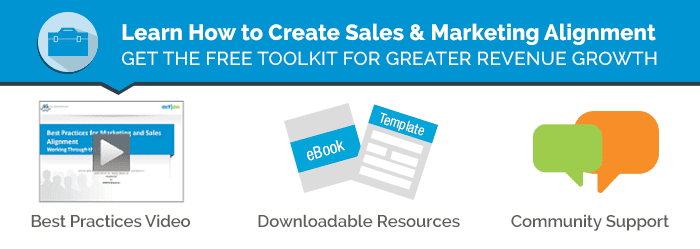 Sales: “The leads from marketing are weak!”
Sales: “The leads from marketing are weak!”
Marketing: “Sales can’t close on the great leads we give them!”
And so went the age-old debate between sales and marketing … but times and tools have changed. There’s no longer a reason for a pointless battle between two departments that belong to the same company. Two little words can lead to a harmonious relationship between former rivals: Sales enablement.
Sales enablement is a strategy to provide the sales department with leads, data, tools and content that helps them sell more successfully and generate revenue. Your marketing team can play a vital role in increasing the success of your sales team and, ultimately, the profits and success of your company, in measurable ways.
Sales Enablement
What It Is
Sales enablement is primarily about providing salespeople with what they need, when they need it, to successfully engage their target buyers throughout the customer lifecycle. This allows the salesperson to deliver a customized, meaningful experience that’s more likely to help convert prospects to loyal customers who go on to share their enthusiasm with others.
Sales enablement involves placing more emphasis on the buyer’s interests and needs and involves a variety of components which allow marketers and sales reps to work smarter, not harder. (And to work together.)
Why It’s Important to Marketers
It’s Not Like the Old Days
Simply put, marketing has changed – a lot. Back in the day, a marketer’s job was mainly about pushing out one-way messages to consumers about products and services, and hoping something struck a chord.
Now that automated marketing is here, it’s a two-way street. You’re inviting customers to seek out your company’s services and to willingly place themselves into your lead generation funnel via your website, content and social media platforms as they connect with sources of information and trusted advice generated by your team. It’s about inviting people in, welcoming them when they arrive, and making sure they’re happy once they’ve committed to staying.
Marketing is now very revenue- and technology-driven:
- It enables the delivery of valuable information to buyers in a scalable, controllable way
- Marketing now often owns a “revenue number”
- Technology spend is accelerating – it’s not unusual for CMOs to have larger technology budgets than CTOs
- Hitting a number, owning responsibility for customer-relationship-building throughout the lifecycle and investing in technology produces lots of data, so data-driven marketing is quickly becoming priority #1 for marketers.
Which brings us to our next point:
Digital Marketing is Measurable, So It’s Easier to Prove Your Value
Besides enabling prospects to find and interact with your company more easily, automated marketing also allows you to measure the results of your efforts, including factors such as who visitors are, how they find your site, how they’re accessing your information, where they work, and more. This relates to sales enablement because marketing is now more responsible than ever for delivering qualified leads that convert into bona-fide opportunities.
Using the rich analytics available to you through automated programs helps marketing to optimize future sales enablement efforts based on what does, and doesn’t, connect with audiences. When executed correctly, attraction, conversion, and retention numbers begin to soar very quickly and the marketing team’s ROI is very easy to validate with reports and data.
 Your Bosses are Watching
Your Bosses are Watching
Because sales enablement leads to differentiation between competitors, higher customer satisfaction, and increased profits, executive teams now have a laser-focus on conversion rates at all stages rather than just lead numbers, and are holding marketing accountable. No one wants to be responsible for longer sales cycles or lost revenue opportunities.
When you’re utilizing marketing automation tools to generate qualified leads, deliver customized content to customers and boost sales and retention, you’ll relish rather than dread the reports your bosses are reading.
Stats Show Sales Enablement Works
Numbers don’t lie.
- Demand Gen Report: 95% of B2B purchase decisions are directly influenced by content
- MarketingSherpa: Adding lead scoring to your existing marketing automation and CRM environment can decrease non-ready leads sent to sales by 52% while increasing revenue by 41%.
- Aberdeen Research Group: 51% improvement in lead conversion rates and 54% year-over-year increase in sales reps attaining quotas
How to Accomplish It
Know Your Target
Sure, marketers know they should be able to identify their target audiences, but developing content for, and marketing to, today’s buyer is more complex than ever. Having a deep understanding of who your tech-savvy contemporary buyers are, what they want, and when they want it is crucial in order to achieve the primary goal of marketers: to get the right message to the right people at the right time.
Other tips for honing in on your target:
- Know that SEO is important, but remember that you’re ultimately writing for human beings, not search engines.
- Tap into internal (particularly sales and customer support) resources to gain valuable input and insights into just who you’re writing for and what they want to know.
- Use analytics tools and software functions to gather data about current customers to educate yourself about what they buy, read, share and respond to.
- Test your messaging, landing pages and email campaigns; what works for one segment may not work for another. With A/B testing you can get it right the first time, and be just that much further ahead as you iterate.
Lead Scores and Alerts – Have a Plan
Part of your job is to generate qualified leads that translate into qualified opportunities and won deals. There’s a simple equation behind how to score leads: actions + attributes = lead score.
But it doesn’t do any good to have the right information ready to go to leads if it isn’t delivered at the right time. Once your teams have determined when and to whom lead alerts will be sent, with a well-integrated sales and marketing technology platform, you have the option of automating those tasks.
Follow Up with Content
The other key component to successful modern marketing is having the ability to create and deliver content that helps sales teams advance and close deals. Ease–of–use is the key to getting salespeople to use the resources you create – and you need to make sure they’re easy to find.
Some examples of content that salespeople use at customer lifecycle stages are:
- Attract: Content (social media, blog posts, white papers, webinars…) that’s relevant and gets the attention of contacts during the prospecting stage, particularly pieces that educate audiences on new technology, trends, challenges and give tips for success
- Capture: Forms and landing pages to encourage visitors to share their contact information in order to gain permission to market to them, and provide them with customized experiences
- Nurture: Useful resources and links to share during email and social selling campaigns
- Convert: Customer testimonials and case studies
- Expand: Blog posts and email newsletters about new products, services, and updates on existing tools aimed at current customers in order to keep them informed and prevent churn, and that are compelling enough to for industry influencers to share
It’s a major paradigm shift to say that, in today’s B2B environment, marketing and sales aren’t enemies, but quite the opposite – partners working together, for mutual gain. The marketing teams that understand this are learning how to evaluate, implement, and execute sales enablement strategies and tools that empower sales to gain and hold people’s attention, sell more effectively, and earn customer love and loyalty.
By focusing on the changing dynamics of the buyer’s journey and by customizing the customer’s experience to make it relevant and enjoyable, you will help enable sales to dramatically increase the bottom line – and that’s good for everyone.
Are you ready to mold together your sales and marketing departments? Sales enablement implementation can be a lot quicker and easier with a resource like our Free Toolkit: Aligning Sales & Marketing for Greater Revenue Growth. Download it for free, and join the list of well-aligned organizations that have seen an average of 32% annual revenue growth!


